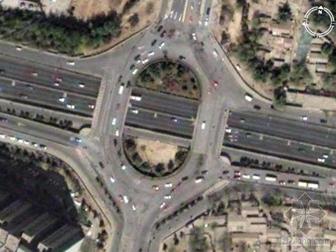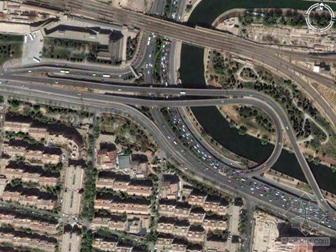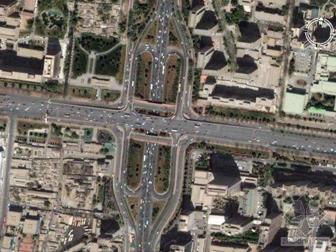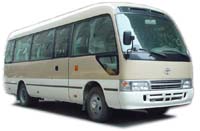1st Ring Road
 The 1st Ring Road no longer exists under that name. In the 1920s, around half a dozen routes were established in Beijing for the first tram lines of the city. In addition to different numbers, different tram lines were also further distinguished from each other by the unique color of the signs at the stops for each line. Number 4 line with white signs at stops traveled on a route that had a ring shape: It ran clockwise through Tiananmen - Xidan -Xisi - Pinganli -Dianmen - Gulou -Jiaodaokou - Beixingqiao - Dongsi - Dongdan - Tiananmen, with a total length of 17 kilometers. This route was known as the “Ring Road” (city
loops). After the tramlines were removed in the 1950s, this name lost its meaning as it was simply a collection of surface streets (in contrast, each of the other ring roads today is a single expressway). Most maps in Beijing do not actually show the 1st Ring Road as such; only very few maps give a faint yellow highlight of a possible variant of it. However, the original name remained to be used later for other ring roads constructed decades later. The 1st Ring Road no longer exists under that name. In the 1920s, around half a dozen routes were established in Beijing for the first tram lines of the city. In addition to different numbers, different tram lines were also further distinguished from each other by the unique color of the signs at the stops for each line. Number 4 line with white signs at stops traveled on a route that had a ring shape: It ran clockwise through Tiananmen - Xidan -Xisi - Pinganli -Dianmen - Gulou -Jiaodaokou - Beixingqiao - Dongsi - Dongdan - Tiananmen, with a total length of 17 kilometers. This route was known as the “Ring Road” (city
loops). After the tramlines were removed in the 1950s, this name lost its meaning as it was simply a collection of surface streets (in contrast, each of the other ring roads today is a single expressway). Most maps in Beijing do not actually show the 1st Ring Road as such; only very few maps give a faint yellow highlight of a possible variant of it. However, the original name remained to be used later for other ring roads constructed decades later.
The notion of "1st Ring Road" briefly reappeared after the end of the Cultural Revolution, during which the original names of the roads described above were changed to names with strong political propaganda meaning that eulogized and advocated the ideologies of the Cultural Revolution, and when the political turmoil had ended, the names obviously had to be changed again. One suggestion was to completely rename those roads as "1st Ring Road" to symbolize the new start in the era of reform, as well as to reflect the willingness of China to embrace modernness and globalization, but this suggestion was quickly turned down because most people favored the original names of the roads and believed in their historical meaning and cultural heritage, and more importantly, they felt that returning the original names also had more symbolic meaning of denouncing Cultural Revolution. Therefore, the original names of the roads were adopted once again, and the phrase "1st Ring Road" was seldom heard again.
2nd Ring Road
 Actually Beijing's first ring road, the 2nd Ring Road was built in the 1980s and expanded in the 1990s. It now forms a rectangular loop around central Beijing, an area that is roughly equivalent to the old city, which includes the four precincts: Dongcheng Qu (Eastern Urban Precinct), Xicheng Qu (Western Urban Precinct), Xuanwu Precinct and Chongwen Precinct. Its four sections begin at Xizhimen, Dongzhimen, Caihuying and Zuo'anmen. Actually Beijing's first ring road, the 2nd Ring Road was built in the 1980s and expanded in the 1990s. It now forms a rectangular loop around central Beijing, an area that is roughly equivalent to the old city, which includes the four precincts: Dongcheng Qu (Eastern Urban Precinct), Xicheng Qu (Western Urban Precinct), Xuanwu Precinct and Chongwen Precinct. Its four sections begin at Xizhimen, Dongzhimen, Caihuying and Zuo'anmen.
The 2nd Ring Road passes through very central parts of Beijing, and is directly above the Beijing Railyway Station. Prices of real estate inside the ring road are considerably higher than other parts of town.
The 2nd Ring Road of today is part of an extended ring road which takes the southern route through Zuo'anmen and Caihuying instead of Qianmen, just south of Tian'anmen.
3rd Ring Road
 The 3rd Ring Road was built in the 1980s and completed in the 1990s. It also is central, as it passes through Beijing's CBD and diplomatic communities. It is the ring road closest to the city to be directly interlinked with expressways—the Airport Expressway, the Jingcheng Expressway (link under construction), the Badaling Expressway the Jingshi Expressway, the Jingkai Expressway and the Jingjintang Expressway. The 3rd Ring Road was built in the 1980s and completed in the 1990s. It also is central, as it passes through Beijing's CBD and diplomatic communities. It is the ring road closest to the city to be directly interlinked with expressways—the Airport Expressway, the Jingcheng Expressway (link under construction), the Badaling Expressway the Jingshi Expressway, the Jingkai Expressway and the Jingjintang Expressway.
4th Ring Road
The 4th Ring Road was completed in 2001, around 8 km from the center of Beijing. It connects the less central parts of Beijing and navigates through Zhongguancun technology hub, western Beijing, Fengtai District/Precinct, and eastern Beijing. The Jingshen Expressway and the Jington Expressway (as of Dawangqiao) begin from the 4th Ring Road.
The 4th Ring Road, along with other ring roads, now have a few locations where "fake" police lights (red and blue in colour) light up at night. Drivers are easily fooled into thinking that the police is out in force. This indirectly forces drivers to slow down.
5th Ring Road
This ring road is further distant (around 10 km) from central Beijing, and links the suburban areas of Huantie, Shigezhuang, Dingfuzhuang and Ciqu. It also passes through the Beijing Development Area It navigates through very barren land in the south before heading west toward the Fragrant Hills.
Due to its proximity to Olympic venues, it has been nicknamed the "Olympic Avenue."
6th Ring Road
At present the most remote ring road from central Beijing (around 15 – 20 km), the 6th Ring Road was built in the 2000s and has just recently been completed. 130 km of expressway between the interchanges with Badaling Expressway and Jingshi Expressway, running clockwise, are open to the general motoring traffic. It is the only ring road to be interlinked with the equally remote Jingha Expressway.
This toll expressway ring road links Beijing with Shunyi District, Tongzhou District, Changping District and Daxing District.
Check our Beijing Bus Tour Programs. You can tour Beijing with our
group bus tour programs for various routes.
Learn more about Beijing private and
non-private tours.

|



 The 1st Ring Road no longer exists under that name. In the 1920s, around half a dozen routes were established in Beijing for the first tram lines of the city. In addition to different numbers, different tram lines were also further distinguished from each other by the unique color of the signs at the stops for each line. Number 4 line with white signs at stops traveled on a route that had a ring shape: It ran clockwise through Tiananmen - Xidan -Xisi - Pinganli -Dianmen - Gulou -Jiaodaokou - Beixingqiao - Dongsi - Dongdan - Tiananmen, with a total length of 17 kilometers. This route was known as the “Ring Road” (city
loops). After the tramlines were removed in the 1950s, this name lost its meaning as it was simply a collection of surface streets (in contrast, each of the other ring roads today is a single expressway). Most maps in Beijing do not actually show the 1st Ring Road as such; only very few maps give a faint yellow highlight of a possible variant of it. However, the original name remained to be used later for other ring roads constructed decades later.
The 1st Ring Road no longer exists under that name. In the 1920s, around half a dozen routes were established in Beijing for the first tram lines of the city. In addition to different numbers, different tram lines were also further distinguished from each other by the unique color of the signs at the stops for each line. Number 4 line with white signs at stops traveled on a route that had a ring shape: It ran clockwise through Tiananmen - Xidan -Xisi - Pinganli -Dianmen - Gulou -Jiaodaokou - Beixingqiao - Dongsi - Dongdan - Tiananmen, with a total length of 17 kilometers. This route was known as the “Ring Road” (city
loops). After the tramlines were removed in the 1950s, this name lost its meaning as it was simply a collection of surface streets (in contrast, each of the other ring roads today is a single expressway). Most maps in Beijing do not actually show the 1st Ring Road as such; only very few maps give a faint yellow highlight of a possible variant of it. However, the original name remained to be used later for other ring roads constructed decades later. Actually Beijing's first ring road, the 2nd Ring Road was built in the 1980s and expanded in the 1990s. It now forms a rectangular loop around central Beijing, an area that is roughly equivalent to the old city, which includes the four precincts: Dongcheng Qu (Eastern Urban Precinct), Xicheng Qu (Western Urban Precinct), Xuanwu Precinct and Chongwen Precinct. Its four sections begin at Xizhimen, Dongzhimen, Caihuying and Zuo'anmen.
Actually Beijing's first ring road, the 2nd Ring Road was built in the 1980s and expanded in the 1990s. It now forms a rectangular loop around central Beijing, an area that is roughly equivalent to the old city, which includes the four precincts: Dongcheng Qu (Eastern Urban Precinct), Xicheng Qu (Western Urban Precinct), Xuanwu Precinct and Chongwen Precinct. Its four sections begin at Xizhimen, Dongzhimen, Caihuying and Zuo'anmen. The 3rd Ring Road was built in the 1980s and completed in the 1990s. It also is central, as it passes through Beijing's CBD and diplomatic communities. It is the ring road closest to the city to be directly interlinked with expressways—the Airport Expressway, the Jingcheng Expressway (link under construction), the Badaling Expressway the Jingshi Expressway, the Jingkai Expressway and the Jingjintang Expressway.
The 3rd Ring Road was built in the 1980s and completed in the 1990s. It also is central, as it passes through Beijing's CBD and diplomatic communities. It is the ring road closest to the city to be directly interlinked with expressways—the Airport Expressway, the Jingcheng Expressway (link under construction), the Badaling Expressway the Jingshi Expressway, the Jingkai Expressway and the Jingjintang Expressway.